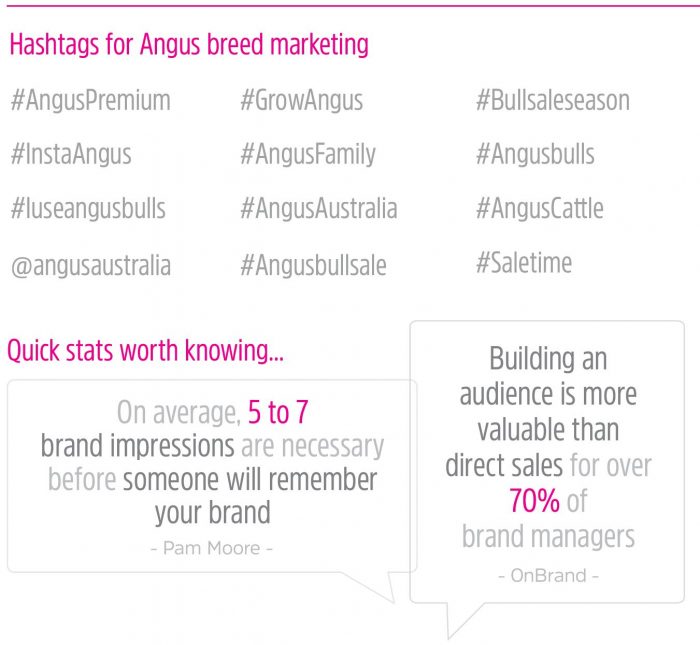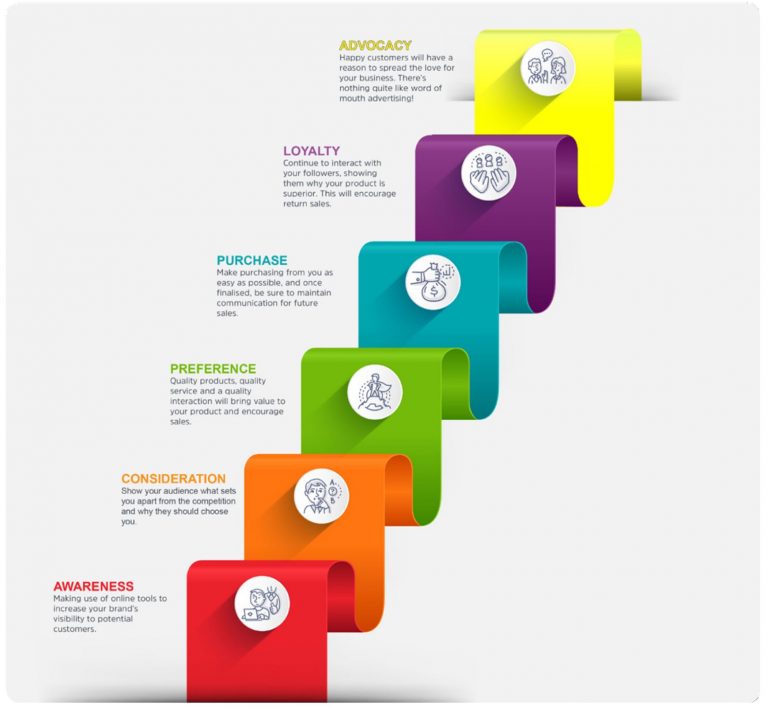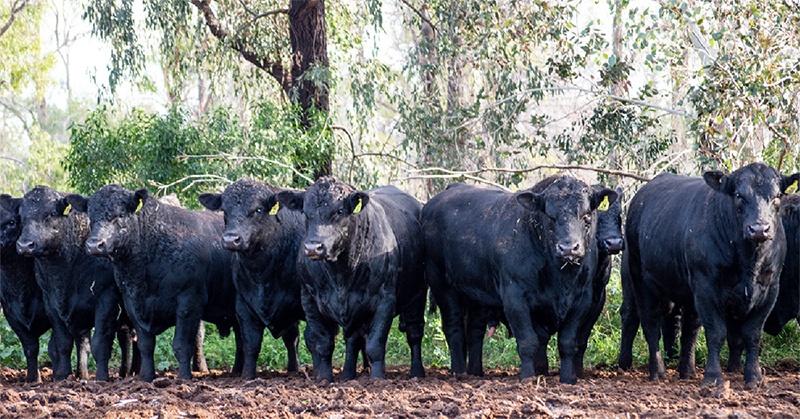You’re an Angus producer, you’ve developed your animals, and your business is in a pretty good place, but is that enough? How can you go bigger and better?
Angus Australia has developed a series of marketing basics; practical ideas that you can start doing today to help you get more out of your business and the Angus brand.
This series will cover the basics that you need to get your business out there. The series will include:
- What is marketing and why you should make use of it
- Being seen on Google
- Setting up social media
- What to share and when to share
- How to video
So what is marketing?
Marketing is the process of guiding consumers to engage with your products instead of your competitors. It is everything that the consumer encounters when interacting with your business. This involves everything from advertising and editorials to customer service and even word of mouth interactions.
That might sound a bit complicated but what it really comes down to is being seen and reaching people. Whether that be when they do a search online, through a search engine like Google or social media, or when you appear in publications like newspapers/industry publications or at events.
As well as promoting your business, marketing can also help you gain a greater insight into who your target audience is and how best to reach them. Ask yourself what the main purpose of your business is? If your aim is to sell cattle, you can make use of marketing tools to get your name out there and to show customers why they should buy your animals and not the competition’s.
Does it mean you need to run out and spend thousands on a brand new website with all the bells and whistles? Not necessarily – there are plenty of things you can do today, with the myriad of online tools that are free and easy and will put you on the right path.
These are the step we’re going to look into.
What advantages does it have to the breeder?
Marketing for the beef breeder adds value to your own product. When it comes down to it, nobody will be knocking the door down to buy your cattle if nobody knows who you are or what is so great about your business. It is up to you as the producer to let prospective buyers know why you are here and why they need you.
It’s about taking advantage of the opportunities at your disposal to make your brand stand out. Spending an hour setting up a free Google business account, even if you don’t have a website, can expose you to a large audience that may have seen you otherwise.
So where do you start?
Think about the following:
- Give yourself a set of goals; what do you want to achieve through this? You might want to raise the profile of your business, show off your products, animals or any number of This will help you work out what content you will need to work on, you might start working on photos videos of your cattle to show how good they are, or you might start an e-newsletter or social media page to reach more people in your industry, just to name a couple of options.
- Resources – this crash course will give you some pointers on how to create content for your business, whether that be videos/photos or written information, but another option is to outsource this, there are marketing businesses out there whose sole purpose is to help you do
- Branding – what you put on your marketing material should correspond to any other advertising/content you’ve You want to create a brand recognisable as you. This will incorporate your logo and any brand colours you use across your resources. Even continuing to use a particular font in your logo and making use of it in other content can be seen as a continuation of your branding.
- What to share: sharing content vs self-promotion – You can talk about the animals you have for sale until the cows come home (excuse the pun), but only talking about that gets boring fairly To really connect with people, rather than just being about your next cattle sale, you could have some fun with it and go into what makes your business unique, who you are, something interesting that’s happening right now, educational or informational content that relates to your business/product that others might get something out of.
- Quality control – Quantity is not better than Don’t feel obliged to make a post every hour of the day, your followers will appreciate less frequent posts if your occasional post is of more worthy quality.
- Open your eyes and ears – Never stop learning or observing, follow anyone and everyone, they don’t even need to be in the same This will help you get an idea of what they’re doing, how you can incorporate those ideas, what’s working for them, what they’re doing right, look at all of that content and think about what you could do and maybe how you could do it better.
- Ask – ask for advice from people who are learning to or running a successful marketing
- SOCIAL media – remember the key word in social media is “Social”. Follow other businesses and interact with I know it’s hard in a busy world to take a moment to do that, but it can be just as important as interacting with people at field days or industry events, and you don’t even need to leave the house to do it.
- Insights – Google and social media platforms can provide excellent insights into the people who are looking at your content. This is incredibly useful information that can help you understand who you’re speaking to, but also the areas that are and aren’t gaining attention so you can understand what’s working for you, what’s popular and what might need more attention on your
Social media – Quick guide
Have you ever wondered what social media platform suits you the best? Below is a brief outline of the core channels that may help you decide.
Twitter: Gives you short bursts of information. It’s a great way to get sale statistics and quick information like your ‘where and when’ for a sale out to a large audience of
people. It promotes straight to the point information sharing and can be a powerful marketing tool if used well.
Instagram: A platform designed to share photos and videos. It is a good way to share your business with the world without the content writing aspect of Facebook and Twitter.
Facebook: A social network where users engage with each other and businesses. Facebooks interactive chat component is great for businesses, as is the ability to share relevant news information easily with your following.
YouTube: A video sharing site that you can create and upload your own content too, as well as viewing other peoples’ work. YouTube is great for uploading your video and then sharing through other social media channels.
What is a (#) hashtag?
You may have seen online that little symbol from the bottom of phone keypads, the # or hashtag.
When you use a hashtag on social media, it makes any word or set of words that is preceded with a # symbol, into a searchable item. This may seem confusing at first but can prove helpful to organise your content or to help create a following for your business.
You just click on the hashtag and see what everyone else in the world is saying about the same thing. Twitter, Facebook, Instagram and Pinterest are all platforms that use the Hashtag system. You can use current hashtags or make your own.
To market the Angus brand we use the following hashtags:
#AngusPremium #GrowAngus #Iuseangusbulls #InstaAngus #AngusAustralia #AngusCattle #AngusFamily
We encourage you to use these hashtags as well. It is important to know that even the smallest Angus breeder can make a difference in the brand reach for both themselves and for the breed as a whole.

Moving Forward
Once you’ve got the basics of marketing in place, how does it all come together?
You can think of it like a ladder with six levels:
- Awareness
- Consideration
- Preference
- Purchase
- Loyalty
- Advocacy
Awareness: Now that you’re visible online and you’re building your brand, people will start to become aware of you. This might begin with you asking your friends and family to follow you on your social media and occasionally share some of your content. From there, friends of friends will start to see what you’re producing, and if they’re interested, they might share and the cycle will continue to build that awareness. To expedite this process you might also want to consider paid advertising, which if used correctly, can be used to reach people who are interested in the products and services you offer and will bypass those people who aren’t. But that’s a topic for another article in the future.
Consideration: You’ve built up awareness and people are following you online. Now that you’ve got their attention, you’ll want to provide them with content to make their awareness of you worth their while. Show them what makes you different/special/unique, but also how that factors into their lives. What will happen if they choose your cattle over the competition’s? Illustrate what makes you’re a better product and why that’s good for them. You can also address a problem they might have and how your product will help them fix that problem. These points will then factor in when they actually go to make a purchase. Make a list of points that set you apart and use that as your basis for creating content that will garner you worthy of your audience’s awareness.
Preference: You’ve got their attention, they’re looking at what you’re selling, but they might be looking at the same product from any number of other suppliers. What now? It comes down to you at this point. This is when it’s a good time to engage with people, open up discussions, be approachable and market yourself just as much as your product. It’s not enough to have just a good product, it’s an entire marketing package. Quality products, quality service and a quality interaction will bring value to make your product more appealing and the customer more likely to prefer you.
Purchase: If your business is already established, you should already have the whole purchase exchange part of things down pat, but one of the main points is to make the process of giving you their money as easy as possible. This of course may or may not be a factor depending on what your enterprise is, but if you’re in a situation where you make direct sales to people, don’t limit how your payments can be made.
Don’t forget while you’re processing that transaction to maintain the interaction with the customer. The sale doesn’t stop once they’ve paid for your product, because if you’ve proved to them that it’s worthy of purchasing, this can be an ongoing relationship that will lead to future sales as well. Give your customers a way to keep in touch with you, you might take their email address and send them information when you’re next having a sale. Make sure to keep the lines of communication open.
Loyalty: Your customer has ticked all the boxes so far, they’ve found you, they’ve agreed that your product is superior and have gone as far as purchasing from you. You’re interacting with them online and reminding them regularly that you’re there. Keep their interest by continuing to give them value. A great way to do this is to connect with them on a personal level. A big part of this is not just posting sale posts. Continue to show those people what you’re doing with your business behind the scenes, show them how you’re adding value to your product, or what’s happening on a regular day, when it’s calving season, make use of all the cuteness, even if you’re just painting the shed, show it and keep the lines of communication open. This encourages your past customers to come back to you when they next decide to make a purchase because they haven’t forgotten about you from last time.
Advocacy: You’ve worked hard and followed all the steps so far, and all going well, it’s working. And if that’s the case, the next marketing step will be done for you. Those people you’ve impressed with the quality of your product or service will go on to advocate for you out there in the world. If you’ve shown them that you love your business and they agree and love it too, they will share that information with people. The hard part is done at the beginning of the process, acquiring new customers is always going to be a challenge, but once you have them it’s always much easier to keep them coming back and hopefully when you repeat the cycle, the process will be that much easier next time because you have existing customers working to help you too.
If you have any questions or have content suggestions please contact Kate Reynolds at design@angusaustralia. com.au.



